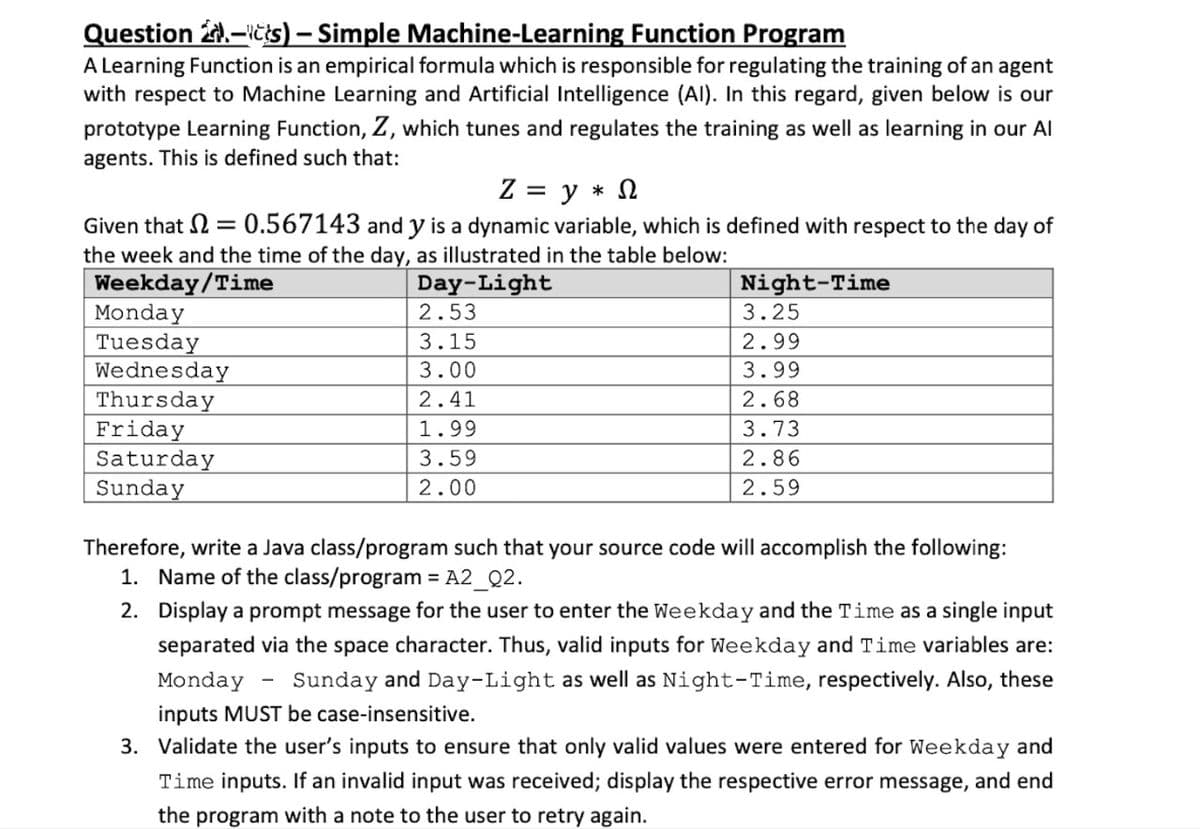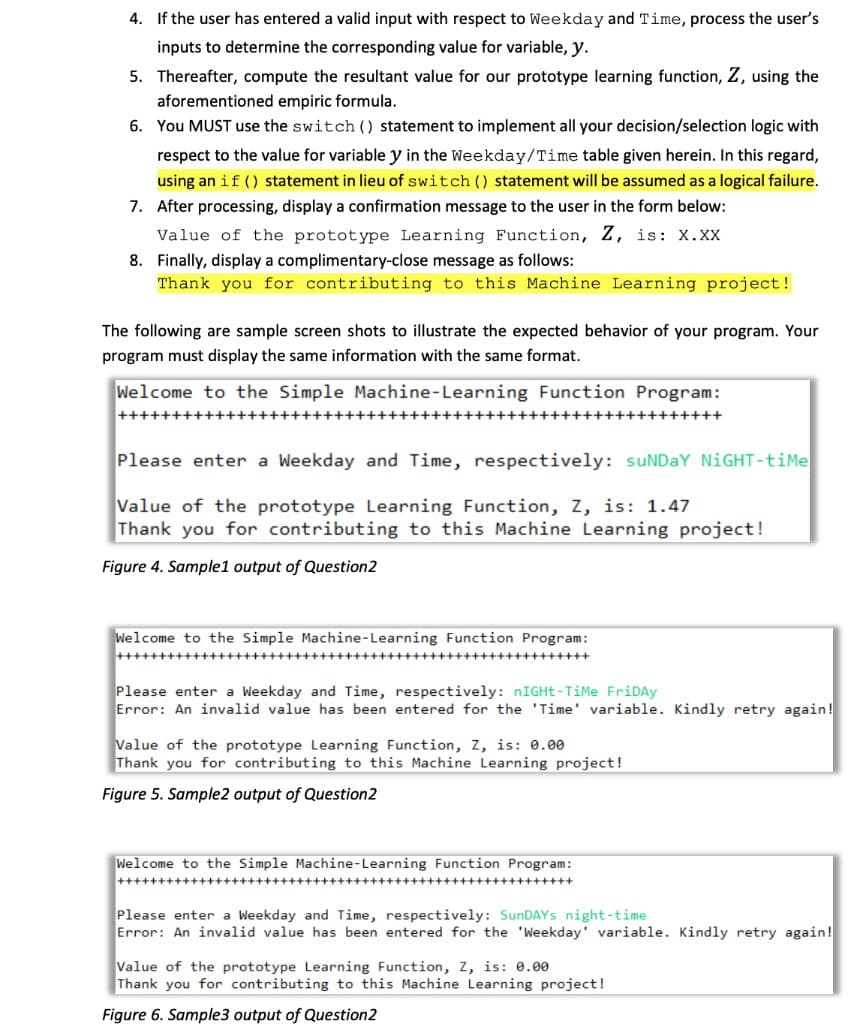espect to Machine Learning and Artificial Intelligence (Al). In this regard, given below type Learning Function, Z, which tunes and regulates the training as well as learning in s. This is defined such that: Z = y * N that N = 0.567143 and y is a dynamic variable, which is defined with respect to the eek and the time of the day, as illustrated in the table below: kday/Time day sday nesday Day-Light 2.53 Night-Time 3.25 3.15 2.99 3.00 3.99
espect to Machine Learning and Artificial Intelligence (Al). In this regard, given below type Learning Function, Z, which tunes and regulates the training as well as learning in s. This is defined such that: Z = y * N that N = 0.567143 and y is a dynamic variable, which is defined with respect to the eek and the time of the day, as illustrated in the table below: kday/Time day sday nesday Day-Light 2.53 Night-Time 3.25 3.15 2.99 3.00 3.99
Computer Networking: A Top-Down Approach (7th Edition)
7th Edition
ISBN:9780133594140
Author:James Kurose, Keith Ross
Publisher:James Kurose, Keith Ross
Chapter1: Computer Networks And The Internet
Section: Chapter Questions
Problem R1RQ: What is the difference between a host and an end system? List several different types of end...
Related questions
Question

Transcribed Image Text:Question 2.-ičis) – Simple Machine-Learning Function Program
A Learning Function is an empirical formula which is responsible for regulating the training of an agent
with respect to Machine Learning and Artificial Intelligence (Al). In this regard, given below is our
prototype Learning Function, Z, which tunes and regulates the training as well as learning in our Al
agents. This is defined such that:
Z = y * N
Given that 2 = 0.567143 and y is a dynamic variable, which is defined with respect to the day of
the week and the time of the day, as illustrated in the table below:
Weekday/Time
Monday
Tuesday
Wednesday
Thursday
Friday
Saturday
Sunday
Day-Light
2.53
Night-Time
3.25
3.15
2.99
3.00
3.99
2.41
2.68
1.99
3.73
3.59
2.86
2.00
2.59
Therefore, write a Java class/program such that your source code will accomplish the following:
1. Name of the class/program = A2_Q2.
%3D
2. Display a prompt message for the user to enter the Weekday and the Time as a single input
separated via the space character. Thus, valid inputs for Weekday and Time variables are:
Monday
Sunday and Day-Light as well as Night-Time, respectively. Also, these
inputs MUST be case-insensitive.
3. Validate the user's inputs to ensure that only valid values were entered for Weekday and
Time inputs. If an invalid input was received; display the respective error message, and end
the program with a note to the user to retry again.

Transcribed Image Text:4. If the user has entered a valid input with respect to Weekday and Time, process the user's
inputs to determine the corresponding value for variable, y.
5. Thereafter, compute the resultant value for our prototype learning function, Z, using the
aforementioned empiric formula.
6. You MUST use the switch () statement to implement all your decision/selection logic with
respect to the value for variable y in the Weekday/Time table given herein. In this regard,
using an if () statement in lieu of switch () statement will be assumed as a logical failure.
7. After processing, display a confirmation message to the user in the form below:
Value of the prototype Learning Function, Z, is: X.XX
8. Finally, display a complimentary-close message as follows:
Thank you for contributing to this Machine Learning project!
The following are sample screen shots to illustrate the expected behavior of your program. Your
program must display the same information with the same format.
Welcome to the Simple Machine-Learning Function Program:
++++++++++++++++++++++++++++++++++++++++++++++++++++++++
Please enter a Weekday and Time, respectively: suNDaY NIGHT-tiMe
Value of the prototype Learning Function, Z, is: 1.47
Thank you for contributing to this Machine Learning project!
Figure 4. Sample1 output of Question2
Welcome to the Simple Machine-Learning Function Program:
+++++++++
++++++++++
Please enter a Weekday and Time, respectively: NIGHT-TiMe FriDAy
Error: An invalid value has been entered for the 'Time' variable. Kindly retry again!
Value of the prototype Learning Function, z, is: 0.00
Thank you for contributing to this Machine Learning project!
Figure 5. Sample2 output of Question2
Welcome to the Simple Machine-Learning Function Program:
Please enter a Weekday and Time, respectively: SunDAYs night-time
Error: An invalid value has been entered for the 'Weekday' variable. Kindly retry again!
Value of the prototype Learning Function, z, is: 0.00
Thank you for contributing to this Machine Learning project!
Figure 6. Sample3 output of Question2
Expert Solution
This question has been solved!
Explore an expertly crafted, step-by-step solution for a thorough understanding of key concepts.
Step by step
Solved in 4 steps with 7 images

Recommended textbooks for you

Computer Networking: A Top-Down Approach (7th Edi…
Computer Engineering
ISBN:
9780133594140
Author:
James Kurose, Keith Ross
Publisher:
PEARSON

Computer Organization and Design MIPS Edition, Fi…
Computer Engineering
ISBN:
9780124077263
Author:
David A. Patterson, John L. Hennessy
Publisher:
Elsevier Science

Network+ Guide to Networks (MindTap Course List)
Computer Engineering
ISBN:
9781337569330
Author:
Jill West, Tamara Dean, Jean Andrews
Publisher:
Cengage Learning

Computer Networking: A Top-Down Approach (7th Edi…
Computer Engineering
ISBN:
9780133594140
Author:
James Kurose, Keith Ross
Publisher:
PEARSON

Computer Organization and Design MIPS Edition, Fi…
Computer Engineering
ISBN:
9780124077263
Author:
David A. Patterson, John L. Hennessy
Publisher:
Elsevier Science

Network+ Guide to Networks (MindTap Course List)
Computer Engineering
ISBN:
9781337569330
Author:
Jill West, Tamara Dean, Jean Andrews
Publisher:
Cengage Learning

Concepts of Database Management
Computer Engineering
ISBN:
9781337093422
Author:
Joy L. Starks, Philip J. Pratt, Mary Z. Last
Publisher:
Cengage Learning

Prelude to Programming
Computer Engineering
ISBN:
9780133750423
Author:
VENIT, Stewart
Publisher:
Pearson Education

Sc Business Data Communications and Networking, T…
Computer Engineering
ISBN:
9781119368830
Author:
FITZGERALD
Publisher:
WILEY